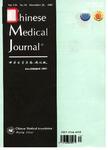Analysis of low-density lipoprotein receptor gene mutations in a Chinese patient with clinically homozygous familial hypercholesterolemia
Analysis of low-density lipoprotein receptor gene mutations in a Chinese patient with clinically homozygous familial hypercholesterolemia作者机构:Laboratory of Infection and ImmunityCapital Institute of Pediatrics Institute of Heart Lung and Blood Vessel Diseases State Key Laboratory of Medical Molecular BiologyBasic Medical Institute Chinese Academy of Medical Sciences
出 版 物:《Chinese Medical Journal》 (中华医学杂志(英文版))
年 卷 期:2003年第116卷第10期
页 面:1535-1538页
核心收录:
学科分类:0710[理学-生物学] 1002[医学-临床医学] 07[理学] 100201[医学-内科学(含:心血管病、血液病、呼吸系病、消化系病、内分泌与代谢病、肾病、风湿病、传染病)] 071007[理学-遗传学] 10[医学]
主 题:familial hypercholesterolemia low-density lipoprotein polymerase chain reaction DNA sequencing
摘 要:Objective To screen the point mutation of the low-density lipoprotein receptor (LDL-R) gene in Chinese familial hypercholesterolemia (FH) patients,characterize the relationship between the genotype and the phenotype and discuss the molecular pathological mechanism of FH. Methods A patient with clinical phenotype of homozygous FH and her parents were investigated for mutations in the promoter and all eighteen exons of the LDL-R gene. Screening was carried out using Touch-down PCR and direct DNA sequencing; multiple alignment analysis by DNASIS 2.5 was used to find base alteration,and the LDL-R gene mutation database was searched to identify the alteration. In addition,the apolipoprotein B gene (apo B) was screened for known mutations (R3500Q) that cause familial defective apo B 100 (FDB) by polymerase chain reaction-restriction fragment length polymorphism (PCR-RFLP).Results Two new heterozygous mutations in exons 4 and 9 of the LDL-R gene were identified in the proband (C122Y and T383I) as well as her parents. Both of the mutations have not been published in the LDL-R gene mutation database. No mutation of apo B 100 (R3500Q) was observed. Conclusion Two new mutations (C112Y and T383I) were found in the LDL-R gene,which may result in FH and may be particularly pathogenetic genotypes in Chinese people.



